Ap biology macromolecules Study guides, Class notes & Summaries
Looking for the best study guides, study notes and summaries about Ap biology macromolecules? On this page you'll find 81 study documents about Ap biology macromolecules.
Page 4 out of 81 results
Sort by
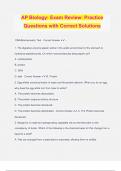
-
AP Biology: Exam Review: Practice Questions with Correct Solutions
- Exam (elaborations) • 83 pages • 2024
-
- $14.49
- + learn more
AP Biology: Exam Review: Practice Questions with Correct Solutions DNA/Biochemestry Test - Correct Answer ️️ --- 1. The digestive enzyme pepsin works in the acidic environment of the stomach to hydrolyze peptide bonds. On which macromolecules does pepsin act? A. carbohydrate B. protein C. DNA D. lipid - Correct Answer ️️ -B. Protein 2. Egg whites consist primarily of water and the protein albumin. When you fry an egg, why does the egg white turn from clear to white? A. The pro...
 Popular
Popular
-
AP Biology notes EVERY UNIT! (taught by a Dr. in Biochemistry)
- Class notes • 57 pages • 2024
-
- $14.89
- 1x sold
- + learn more
A 57 page Google doc turned into a pdf that covers everything YOU need to know for AP Biology. My teacher is Dr. John Fuller who has a PhD in biochemistry from UCLA. Dr. Fuller has also done research in labs and contributed to academic papers, one of the most groundbreaking academic papers being about homeobox genes, which just happens to be in the cirriculum for AP Bio. There are also Google slides that Dr. Fuller has made over his 20+ years of teaching AP Biology for unit 8 and other units (...
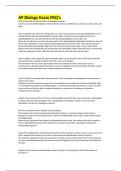
-
AP Biology Exam FRQ's (Unit 1)
- Exam (elaborations) • 3 pages • 2024
-
- $10.39
- + learn more
AP Biology Exam FRQ's (Unit 1) Describe the role of carbon in biological systems. Carbon is used to build biological macromolecules such as carbohydrates, proteins, nucleic acids, and lipids. (Unit 1) Explain how, when the membranes are fused, the polar parts of the phospholipids from one cell will interact with the phospholipids from the other cell and how the nonpolar parts of the phospholipids from one cell will interact with the phospholipids from the other cell. When the membranes ...

-
AP Biology - The Chemistry of Life Exam Study Guide.
- Exam (elaborations) • 8 pages • 2024
- Available in package deal
-
- $11.49
- + learn more
AP Biology - The Chemistry of Life Exam Study Guide. Elements - answersubstances that cannot be broken down into simpler substances by chemical means CHNOPS - answeran acronym representing the 6 key elements of life carbon - answerkey element of life; major component of ALL organic compounds, including all 4 types of macromolecules (sugars, fats, proteins, and nucleic acids); rarely found unbound to other elements hydrogen - answerkey element of life, highly involved in the creation of p...

-
AP Biology: Macromolecules Exam Study Guide with Complete Solutions
- Exam (elaborations) • 7 pages • 2024
- Available in package deal
-
- $9.99
- + learn more
AP Biology: Macromolecules Exam Study Guide with Complete Solutions Macromolecules - Answer️️ -Molecules composed of thousands of atoms: the four main classes being carbohydrates, lipids, prteins, and nucleic acids Polymer - Answer️️ -Chainlike molecules, consisting of many similar or identical building blocks linked by covalent bonds. Monomer - Answer️️ -Make up polymers: connected by covalent bonds. Dehydration Synthesis - Answer️️ -(Condensation Reaction): Covalent bond...
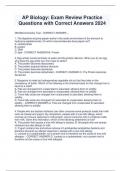
-
AP Biology: Exam Review Practice Questions with Correct Answers 2024
- Exam (elaborations) • 46 pages • 2024
- Available in package deal
-
- $17.99
- + learn more
AP Biology: Exam Review Practice Questions with Correct Answers 2024 DNA/Biochemestry Test - CORRECT ANSWER--- 1. The digestive enzyme pepsin works in the acidic environment of the stomach to hydrolyze peptide bonds. On which macromolecules does pepsin act? A. carbohydrate B. protein C. DNA D. lipid - CORRECT ANSWER-B. Protein 2. Egg whites consist primarily of water and the protein albumin. When you fry an egg, why does the egg white turn from clear to white? A. The protein bec...
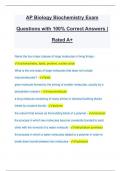
-
AP Biology Biochemistry Exam Questions with 100% Correct Answers | Rated A+
- Exam (elaborations) • 10 pages • 2024
-
- $9.99
- + learn more
AP Biology Biochemistry Exam Questions with 100% Correct Answers | Rated A+ Name the four major classes of large molecules in living things - carbohydrates, lipids, proteins, nucleic acids What is the one class of large molecules that does not include macromolecules? - lipids giant molecule formed by the joining of smaller molecules, usually by a dehydration reaction - macromolecule a long molecule consisting of many similar or identical building blocks linked by covalent bonds - polym...
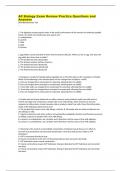
-
AP Biology Exam Review Practice Questions and Answers
- Exam (elaborations) • 42 pages • 2024
-
Available in package deal
-
- $13.49
- + learn more
AP Biology Exam Review Practice Questions and Answers DNA/Biochemestry Test -- 1. The digestive enzyme pepsin works in the acidic environment of the stomach to hydrolyze peptide bonds. On which macromolecules does pepsin act? A. carbohydrate B. protein C. DNA D. lipid B. Protein 2. Egg whites consist primarily of water and the protein albumin. When you fry an egg, why does the egg white turn from clear to white? A. The protein becomes dissociated. B. The protein acquires terti...
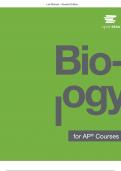
-
Laboratory Manual College Biology for AP Courses Lab Manual by OpenStax (Student Version)
- Exam (elaborations) • 251 pages • 2023
-
- $15.79
- + learn more
Laboratory Manual College Biology for AP Courses Lab Manual by OpenStax (Student Version) Table of Contents Information for the Student 5 Lab 1: Lab Safety, Scientific Method, and Measurements 9 Lab 2: Introduction to Microscopy 16 Lab 3: Macromolecules in Common Food 24 Lab 4: Prokaryotic and Eukaryotic Cells 32 Lab 5: Subcellular Structures 40 Lab 6: Diffusion and Osmosis 50 Lab 7: Factors Affecting the Enzymatic Activity of Lactase 59 Lab 8: Cellular Respiration 68 Lab 9: Fermentat...
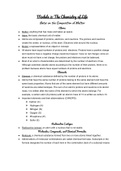
-
The Chemistry of Life
- Summary • 6 pages • 2023
- Available in package deal
-
- $7.99
- 1x sold
- + learn more
This is a thorough and concise 6-page document that summarizes approximately 30 pages of Module 2 from Apologia's Exploring Creation with Biology, 3rd ed. It includes bullet and sub-bullet points of information, vocabulary terms and definitions, and relevant diagrams. Topics include the composition of matter, the properties of water, carbon compounds, and macromolecules (carbs, lipids, proteins, nucleic acids). This summary is highly organized and structured based on the sub-sections of Module 2...

How much did you already spend on Stuvia? Imagine there are plenty more of you out there paying for study notes, but this time YOU are the seller. Ka-ching! Discover all about earning on Stuvia


